A car traveling at 20m/s is attempting to drive up an icy hill. When it gets onto the hill, it is able to go 10 meters before it hits some ice and begins sliding. Assume the hill is a 10 degree incline. A. How far up the hill does the car travel before it starts to slide back down? Make sure to include the initial 10 meters in your final distance. B. If the car then slides all the way back to the bottom of the hill, what is its speed when it gets to the bottom? Assume it doesn’t gain traction back, so it is sliding with no friction the whole way down.
Displacement, Velocity and Acceleration
In classical mechanics, kinematics deals with the motion of a particle. It deals only with the position, velocity, acceleration, and displacement of a particle. It has no concern about the source of motion.
Linear Displacement
The term "displacement" refers to when something shifts away from its original "location," and "linear" refers to a straight line. As a result, “Linear Displacement” can be described as the movement of an object in a straight line along a single axis, for example, from side to side or up and down. Non-contact sensors such as LVDTs and other linear location sensors can calculate linear displacement. Non-contact sensors such as LVDTs and other linear location sensors can calculate linear displacement. Linear displacement is usually measured in millimeters or inches and may be positive or negative.
onto the hill, it is able to go 10 meters before it hits some ice and begins sliding. Assume the hill
is a 10 degree incline.
include the initial 10 meters in your final distance.
gets to the bottom? Assume it doesn’t gain traction back, so it is sliding with no friction
the whole way down.

Trending now
This is a popular solution!
Step by step
Solved in 4 steps with 4 images









